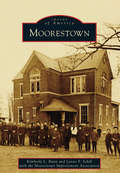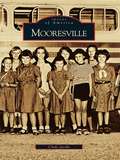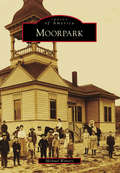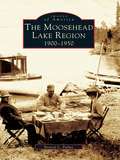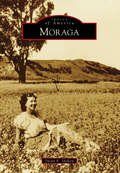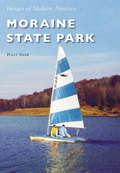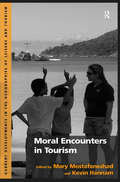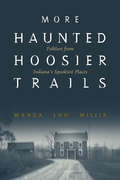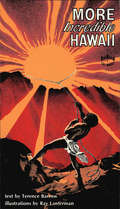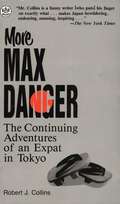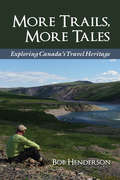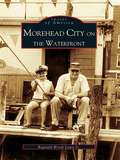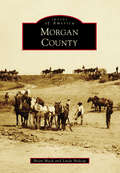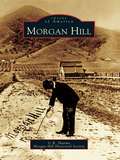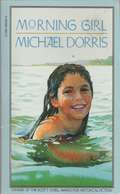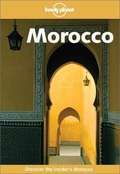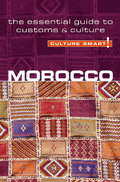- Table View
- List View
Moorestown (Images of America)
by Moorestown Improvement Association Kimberly L. Bunn Lynne F. SchillSettled in 1682 by Quakers, Moorestown grew quickly into an important agricultural and social hub. Local farms and nurseries were considered the best in the state with their superior produce and specimen plants, and the coming of the railroad in the 1860s brought industrial leaders who helped the town to grow and prosper beyond its agrarian roots. It became the home of Eldridge R. Johnson, cofounder of the Victor Talking Machine Company, and Alice Paul, a women's suffrage champion. Moorestown provided easy access to New York City and surrounding urban centers, and it continued to be a mix of sought-after residential neighborhoods, working farms, and thriving businesses. Since 1904, the Moorestown Improvement Association has been instrumental in the town's growth, with contributions including funding the first artesian well, purchasing land for the first parks and athletic fields, and registering the town in the National Register of Historic Places.
Mooresville
by Cindy JacobsIt was a hot afternoon in August 1856 when people in southern Iredell County, North Carolina, gathered for a special event. The train was on its way, bringing officials, a brass band, and the economic future. John Franklin Moore viewed the railroad tracks as an opportunity to fulfill his dream of starting a community and building a town. He knew that trains would bring customers and new citizens and carry freight to and from markets. Moore took a bold step by providing land for a depot and siding and offering land for homes and businesses. Moore's Siding prospered and grew, and in 1873, the village was incorporated and named Mooresville to honor the founder. Generations of Mooresville citizens have taken daring steps into the future, building a community that is more than just a place--it's a home. This is a story of Mooresville, the Queen of Iredell.
Moorhead
by Terry ShoptaughMoorhead, Minnesota, was founded in 1872 as a major stop on the Northern Pacific Railroad during its push toward the Pacific Ocean. The town grew to prominence in western Minnesota because of its location at the intersection of the rail line and the commercially important Red River of the North. Garnering an unenviable reputation in its early years as a wide-open town, dominated by its saloons, Moorhead subsequently developed as an important rural service center. Tracing the history of Moorhead from its founding in 1872 to the present day, the images in this volume reveal the experiences of this small Midwestern community within a framework of change and continuity.
Moorpark (Images of America)
by Michael WintersThe story of Moorpark begins with a town that was built in the right place at the right time. In the 1890s, when the Southern Pacific Railroad announced plans to relocate its Coast Line through Chatsworth to Ventura, land speculation ensued. Robert W. Poindexter, secretary of the Simi Land and Water Company, owned the plot of land that became Moorpark and laid out the townsite in 1900. A depot was quickly built, and soon, trains were arriving daily. Shortly thereafter, an application for a post office was also approved. After the completion of the Santa Susana tunnels in 1904, Moorpark began to grow. Historically, Moorpark's main source of revenue has been agriculture. Initially, dry land farming, including apricots, was preferred. As irrigation techniques improved, walnuts and citrus became the major crops. Its extensive apricot production endowed Moorpark with the title "Apricot Capital of the World." After World War II, the poultry industry became big business, with turkey, chicken, and egg ranches dotting the landscape.
Moosehead Lake Region 1900-1950, The: 1900-1950 (Images of America)
by Everett L. ParkerThe Moosehead Lake region has long been a place where travelers go to escape. In the first half of the twentieth century, the region became a mecca for hunters and fishermen, as well as for travelers looking for rest and relaxation at popular resorts such as the Mount Kineo House. The Moosehead Lake Region: 1900-1950 uses vintage photographs to tell the story of this Maine retreat. The images depict visitors and residents of Greenville, Shirley, Rockwood, Beaver Cove, and Kokadjo; the lumbering era in the North Woods; and the locomotives whose whistles pierced the wilderness.
Moraga (Images of America)
by Susan K. SkiltonLong before the Gold Rush drew settlers from the East, the land that would one day be developed into the town of Moraga was situated on a large rancho owned by the Moraga family. Nestled amongst hills just east of Oakland and Berkeley, the Moraga Valley of the 19th century attracted cattle ranchers and farmers who planted vegetables, fruit, and nuts. In particular, pear orchards established in the earliest farming days are still celebrated in the city's annual Pear & Wine Festival. In the early 20th century, tourists escaped the sometimes chilly and fog-bound cities near San Francisco Bay to picnic in the Moraga redwoods. Electric trains, which brought Moraga's commuters to cities and students to St. Mary's College, enabled the growth of subdivisions and businesses. Train tracks eventually gave way to trails for hiking, biking, and horseback riding. Once considered a potential site for the United Nations, Moraga has maintained its rural beauty while developing into a thriving suburb.
Moraine State Park (Images of Modern America)
by Polly ShawAbout 20,000 years ago, the late Wisconsinan glaciation reached its maximum extent. Glacial deposits identify the moraine, or farthest area covered by the glacier. Muddy Creek was a north-flowing stream that was blocked by the south-advancing glacier, forming a huge lake that lasted until the glacier dam began to retreat. The lake rapidly drained, eventually exposing the vast Muddy Creek basin. Dr. Frank Preston envisioned recreating the ancient glacial lake and worked with the Western Pennsylvania Conservancy to begin the project that became 16,725-acre Moraine State Park. Its centerpiece, man-made Lake Arthur and the surrounds, provide outstanding outdoor recreation and relaxation opportunities.
Moral Encounters in Tourism (Current Developments In The Geographies Of Leisure And Tourism Ser.)
by Mary Mostafanezhad Kevin HannamThis first full length treatment of the role of morality in tourism examines how the tourism encounter is also fundamentally a moral encounter. Drawing upon interdisciplinary perspectives, leading and new authors in the field address topics that range from volunteer tourism to fertility tourism to reveal new insights into the ways tourism encounters are implicated in, and contribute to, broader moral reconfigurations in Western and non-Western contexts. Illustrating the role of power and power relations in tourism encounters within different political, economic, environmental and cultural contexts, the authors in this anthology analyse, theoretically and empirically, the implications of the privileging of some moralities at the expense of others. Key themes include the moral consumption of tourism experiences, embodiment in tourism encounters, environmental moralities as well as methodological aspects of morality in tourism research. Crossing disciplinary and chronological boundaries, Moral Encounters in Tourism provides a much-anticipated overview of this new interdisciplinary terrain and offers possible routes for new research on the intersection of morality and tourism studies.
More Curious
by Sean WilseyIn More Curious, Sean Wilsey travels across the U.S., from the launchpad at Cape Canaveral, to the isolated artists' enclave of Marfa, Texas, to the boardrooms and ballrooms of post-9/11 New York City. Wherever he is, Wilsey captures his surroundings with the precision of a photographer and the raw grace of a skateboarder (he's an amateur practitioner of both arts). And his eye always finds an unrivaled intensity of detail: here, and only here, will a reader be privy to the Dostoyevskian whiff of Marfa's fugitive underbelly, the unsung delights of a skater rag's cooking column, the exact amount of time elapsed since the soundwaves of a long-lost, legendary World Cup broadcast passed out of our solar system.These essays-originally published in Vanity Fair, GQ, McSweeney's, and elsewhere-comprise nearly fifteen years of Wilsey's most vital work on the glory and the misery, the beauty and absurdity of contemporary America.
More Haunted Hoosier Trails
by Wanda Lou WillisIndiana folklorist Wanda Lou Willis is back with all-new ghostly tales in this hair-raising companion to Haunted Hoosier Trails. Wanda explores Indiana's hidden history in spooky locations around the state. Local history buffs will relish the informative county histories that begin each chapter, while thrill-seekers will eagerly search out these frightening spots. More Haunted Hoosier Trails is perfect year-round for raising goose-bumps around the campfire or reading under the covers with a flashlight.
More Hidden Walks in the Bay Area: Pathways, Essays, and Yesterdays
by Stephen AltschulerThe thirty walking tours in the San Francisco Bay Area in this book follow paths, lanes, stairways, and streets. Walkers encounter creeks, waterfalls, redwood groves, and enchanting homes that blend into the landscape.
More Incredible Hawaii
by Terence Barrow Ray LantermanThis book is the fruit of a collaboration between author-anthropologist Terence Barrow and artist-illustrator Ray Lanterman. It is a worthy successor to their INCREDIBLE HAWAil published by the Charles E.Tuttle Company in 1974. The first book was received with enthusiasm by tourists, residents, and school readers of various grades. Teachers said it enlivened Hawaiian history. The fifty-two illustrated essays of MORE INCREDIBLE HAWAII, are even more fascinating than the first series. The convenient format chosen by the publisher is again that of the standard Tut Book noted for high quality paper and presentation. MORE INCREDIBLE HAWAil is an admirable companion to INCREDIBLE HAWAll and should receive the same enthusiastic reception.
More Incredible Hawaii
by Ray Lanterman Terence BarrowThis book is the fruit of a collaboration between author-anthropologist Terence Barrow and artist-illustrator Ray Lanterman. It is a worthy successor to their INCREDIBLE HAWAil published by the Charles E.Tuttle Company in 1974. The first book was received with enthusiasm by tourists, residents, and school readers of various grades. Teachers said it enlivened Hawaiian history. The fifty-two illustrated essays of MORE INCREDIBLE HAWAII, are even more fascinating than the first series. The convenient format chosen by the publisher is again that of the standard Tut Book noted for high quality paper and presentation. MORE INCREDIBLE HAWAil is an admirable companion to INCREDIBLE HAWAll and should receive the same enthusiastic reception.
More Making Out in Korean: (Korean Phrasebook)
by Ghi-Woon SeoMore Making Out in Korea is a fun, accessible and thorough Korean phrase book and guide to the Korean language as it's really spoken.<P><P>This prasebook follows the bestselling Making Out in Korea providing additional (and classic) phrases for travelers, including ones to help you make acquaintances, discuss likes and dislikes, share a meal, go out on the town or develop a romantic relationship.This Korean phrasebook includes: A guide to pronouncing Korean words correctly. Explanations of basic Korean grammar, such as, word order, questions, and formal vs. informal tenses. Complete Korean translations including Korean Script (hangul). Useful and interesting notes on Korean language and culture. Lots of colorful, fun and useful expressions not covered in other phrasebooks.
More Max Danger
by Robert J. CollinsLife with Max Danger is never dull-as all readers of the first, best-selling volume of his adventures as an expatriate in Tokyo will know.More Max Danger provides more entertainment and more pleasure. It will delight not only all of Max's old friends, but also all those who have only recently made his acquaintance.
More Richly in Earth: A Poet’s Search for Mary MacLeod
by Marilyn BoweringMary MacLeod (Màiri nighean Alasdair Ruaidh) was a rarity: a female bard in seventeenth-century Scotland. While her lyrics were honoured, she was also marginalized, denigrated as a witch, and exiled, both for being a writer and for what she wrote.Presented as a chronicle of journeys through the Scottish Hebrides, More Richly in Earth explores MacLeod’s legacy, preserved within landscape, memory, and identity. In an act of recovery and restoration, Canadian poet and novelist Marilyn Bowering pieces together the puzzle of radically different accounts of MacLeod’s life, returning to the places the bard once lived with the help of contemporary Scottish Gaelic poets and scholars. Through investigation and imagination, Bowering forms a connection with MacLeod despite vast differences of culture and language, time and place. Their connection deepens as Bowering twines MacLeod’s story with accounts of the people and places that shaped her own life, a connection that ultimately reveals the foundations of Bowering’s artistic vocation to herself.MacLeod’s life and writing, little known today beyond the Gaelic world, harbours cultural truths about a transformative era of war and colonization in Gaelic Scotland. Bringing a poetic sensibility to investigative scholarship, More Richly in Earth offers a profound reflection on the necessity of art in all forms.
More Trails, More Tales: Exploring Canada's Travel Heritage
by Bob HendersonAn entertaining book of trivia, anecdotes, and observations about heritage travel in Canada. Inspired by and drawing on Canadian exploration, Bob Henderson’s newest book, More Trails, More Tales, strikes a balance with travel literature, history, geography, anthropology, literature, and philosophy. It will delight outdoor enthusiasts, serious naturalists, educators, and armchair travellers alike. It is essentially a storytelling book, highlighting Canadian stories and examining different aspects of heritage travel in Canada.
Morehead City on the Waterfront
by Reginald Worth Lewis Jr.The Morehead City Waterfront in Eastern North Carolina rests on Bogue Sound and the Intracoastal Waterway, with an inlet to the Atlantic Ocean between Shackleford Banks and Fort Macon State Park on North Carolina's Outer Banks. Former North Carolina governor John Motley Morehead planned for the city to be a flourishing commercial port and fishing location-his dream has become a reality. The seaside town thrives on the sound and Intracoastal Waterway, offering visitors and locals a charming, dream-like place to savor a slower pace of life with the richness of the sea air. Visitors flock to the area to enjoy deep-sea fishing in the Gulf Stream, scuba diving to the many wreck sites just off the coast, dining at restaurants that offer famous shore dinners, shopping the many gift stores and art galleries on the waterfront, or just relaxing while watching the boats sail up and down the sound. Morehead City on the Waterfront explores those nostalgic memories of days gone by and the town's unique location on the water.
Morgan County (Images of America)
by Linda Midcap Brian MackPioneers came by the thousands, drawn by the promise of wealth in the Rocky Mountains. The dry, arid plains were a pass-through to most, but a few hardy souls saw potential in the region. They faced the harshest conditions; howling winds, little rainfall, intense heat followed by bone-chilling cold, isolation, and hostile Native American tribes were constant threats to survival. The pioneers of Morgan County were men and women of vision, perseverance, and inner strength. They were problem solvers who dug reservoirs and irrigation canals, built roads and railroads, and created an economy out of what others refused to see. Today, Morgan County is a place of an active agricultural lifestyle, supported by the businesses in the area. Its rich cultural diversity encompasses residents whose countries of origin span the world.
Morgan Hill
by U. R. Sharma Morgan Hill Historical SocietyMorgan Hill lies at the foot of stately El Toro Mountain in southern Santa Clara Valley. Martin Murphy Sr. settled here in 1845, and only a generation later the Murphy family had managed to acquire 70,000 acres. Martin's son Daniel owned over a million acres in the western United States when his only daughter, the beautiful Diana, secretly married Hiram Morgan Hill in 1882. Hiram and Diana inherited part of the original ranch, where they built their lovely Villa Mira Monte. Although the Southern Pacific Railroad tried to name the nearby depot "Huntington," passengers always asked to stop at Morgan Hill's ranch, a popular christening of a community surrounded by thriving orchards and vineyards. After World War II, Morgan Hill became a desirable suburb and has remained so through the birth of Silicon Valley.
Mornings in Mexico (The\cambridge Edition Of The Works Of D. H. Lawrence Ser.)
by D.H. LawrenceFrom the celebrated English author of Sons and Lovers, a collection of essays focused on indigenous life in Mexico and the American Southwest.D. H. Lawrence&’s interest in and real affection for Mexico and the American Southwestern regions and its peoples eclipsed ordinary travel writing. These essays hold great significance for those interested in the wider context of these cultures, as well as those interested in Lawrence as a writer. This is the largest collection of essays about Mexican and Southwestern Indians from Lawrence that has ever been published. Including an early version of &“Pan in America&” which appears here for the first time, previously unpublished passages from other essays, extant manuscripts, typescripts, appendices, and extensive publication notes, this collection contains Lawrence&’s fundamental thoughts on Mesoamerican mythology and history.
Morocco
by Catherine Hanger Moncef LahlouAn exploration of the food & cooking traditions of Morocco & its people.
Morocco
by Bradley Mayhew Jan DoddDiscover ancient and exotic cities, experience the stark beauty of the desert and cool down at the beach. This insider's guide will show you the warmth and color of Morocco.
Morocco - Culture Smart!
by Jillian YorkAbout this Book...Culture Smart! provides essential information on attitudes, beliefs and behavior in different countries, ensuring that you arrive at your destination aware of basic manners, common courtesies, and sensitive issues. These concise guides tell you what to expect, how to behave, and how to establish a rapport with your hosts. This inside knowledge will enable you to steer clear of embarrassing gaffes and mistakes, feel confident in unfamiliar situations, and develop trust, friendships, and successful business relationships.Culture Smart! offers illuminating insights into the culture and society of a particular country. It will help you to turn your visit-whether on business or for pleasure-into a memorable and enriching experience. Contents include* customs, values, and traditions* historical, religious, and political background* life at home* leisure, social, and cultural life* eating and drinking* do's, don'ts, and taboos* business practices* communication, spoken and unspoken"Culture Smart has come to the rescue of hapless travellers." Sunday Times Travel"... the perfect introduction to the weird, wonderful and downright odd quirks and customs of various countries." Global Travel"...full of fascinating-as well as common-sense-tips to help you avoid embarrassing faux pas." Observer"...as useful as they are entertaining." Easyjet Magazine"...offer glimpses into the psyche of a faraway world." New York Times
